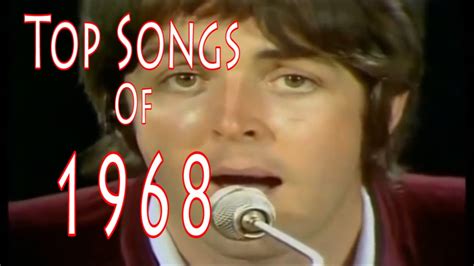1968 was a pivotal year for music, marked by the emergence of new genres, the rise of legendary artists, and the release of iconic songs that continue to influence contemporary music. The year was characterized by a mix of psychedelic rock, folk rock, and the beginning of heavy metal, setting the stage for the diverse musical landscape of the 1970s. This era saw the peak of the counterculture movement, with music playing a central role in expressing the sentiments and ideologies of the time.
Historical Context: Music and Society in 1968
The late 1960s were a time of great social change and upheaval. The civil rights movement, the Vietnam War, and the sexual revolution were just a few of the factors that contributed to a growing sense of disillusionment among young people. Music became a powerful tool for expressing dissent, advocating for social justice, and fostering a sense of community among those seeking change. Bands and artists began to incorporate messages of peace, love, and social commentary into their music, reflecting the turbulent times and the desire for a more harmonious, equitable world.
The Evolution of Music Genres
1968 was also a year of significant musical innovation. The psychedelic sound, which emerged in the mid-1960s, continued to evolve, with bands like Pink Floyd, The Doors, and Jefferson Airplane pushing the boundaries of what was possible in popular music. The introduction of new instruments, recording techniques, and experimental approaches to songwriting resulted in a rich and diverse musical landscape. Simultaneously, the roots of heavy metal were being laid by bands such as Led Zeppelin and Deep Purple, who would go on to define the genre in the following years.
Impact of 1968 Music on Contemporary Culture
The music of 1968 has had a lasting impact on contemporary culture. Many of the songs from this era have become anthems of social change, love, and freedom, continuing to inspire new generations of musicians and fans alike. The experimentation and innovation of 1968 paved the way for a wide range of musical genres, from progressive rock to punk, and influenced the development of music festivals and the live music scene. Today, the music of 1968 remains a testament to the power of art to reflect, shape, and challenge societal norms and values.
Selecting the Top Songs
Selecting the top songs from 1968 is a challenging task, given the sheer volume of outstanding music released that year. However, some songs stand out for their enduring popularity, influence on future musicians, and the role they played in capturing the spirit of the times.
“Hey Jude” by The Beatles: Released in August 1968, “Hey Jude” is one of the most recognizable and beloved songs of all time. Its powerful opening verse, soothing melody, and the iconic “na-na-na” refrain have made it a fan favorite for decades. The song’s message of hope and reassurance resonated deeply with listeners, providing a sense of comfort during a tumultuous period.
“All Along the Watchtower” by Jimi Hendrix: Originally written by Bob Dylan, Jimi Hendrix’s version of “All Along the Watchtower” is often considered one of the greatest cover songs in rock history. Released in September 1968, Hendrix’s unique guitar work and vocal style transformed the song into a psychedelic rock masterpiece, showcasing his innovative approach to music and his ability to reinterpret and reimagine the work of other artists.
“Born to Be Wild” by Steppenwolf: Featured in the iconic movie “Easy Rider,” “Born to Be Wild” has become synonymous with the freedom and rebellion of the 1960s. Released in January 1968, the song’s powerful chorus and John Kay’s distinctive vocals cemented its place in rock history, capturing the essence of the counterculture movement and the desire for liberation and self-expression.
“Sympathy for the Devil” by The Rolling Stones: From their album “Beggars Banquet,” “Sympathy for the Devil” is a samba-inspired track that tells the story of historic events from the perspective of Lucifer. Released in December 1968, the song’s innovative structure, coupled with its controversial subject matter, made it a standout track of the year, demonstrating the band’s willingness to experiment and push the boundaries of what was considered acceptable in popular music.
“White Room” by Cream: Released in September 1968, “White Room” is a testament to Cream’s ability to blend blues, psychedelia, and hard rock. The song features Eric Clapton’s soaring guitar riffs and Jack Bruce’s haunting vocals, making it one of the band’s most enduring songs. The track’s dreamlike quality and poetic lyrics added to its allure, reflecting the band’s interest in exploring the possibilities of psychedelic rock.
Conclusion
The music of 1968 reflects the complexity, creativity, and turmoil of the era. From the psychedelic explorations of Pink Floyd to the emerging heavy metal sound of Led Zeppelin, the year was marked by innovation and experimentation. Songs like “Hey Jude,” “All Along the Watchtower,” “Born to Be Wild,” “Sympathy for the Devil,” and “White Room” not only defined the musical landscape of 1968 but continue to inspire and influence musicians today. As we look back on this pivotal year in music history, it’s clear that the impact of 1968 will be felt for generations to come, a testament to the enduring power of music to capture the essence of an era and to transcend time.
What were some of the most significant musical genres in 1968?
+1968 was a year of great musical diversity, with significant contributions from psychedelic rock, folk rock, and the emerging genre of heavy metal. Each of these genres played a crucial role in shaping the musical landscape of the late 1960s and beyond.
How did the music of 1968 reflect the social and political climate of the time?
+The music of 1968 was deeply intertwined with the social and political upheavals of the era. Many songs addressed themes of peace, love, and social change, reflecting the counterculture movement’s desire for a more just and peaceful world. Artists used their music as a platform to express dissent, advocate for social justice, and promote unity and understanding.
What is the lasting impact of 1968’s music on contemporary culture?
+The music of 1968 has had a profound and lasting impact on contemporary culture. The innovation and experimentation of this era paved the way for a wide range of musical genres and influenced the development of music festivals and the live music scene. Many of the songs from 1968 continue to inspire new generations of musicians and fans, serving as a testament to the power of music to endure beyond its time and to shape the course of cultural history.


